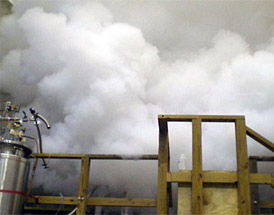
A cloud of helium gas billows out of a quenched superconducting magnet.
In the world of superconducting magnets, "quench" is a technical description for a pretty dramatic event. It means that the magnet crashed, and it will be a while before we can use it again.
The magnet is a coil of superconducting wire that we flow high currents through to produce high magnetic fields. Superconducting magnets are operating in a bath of liquid helium at about -450 degrees Fahrenheit. Quenches usually happen when we are ramping the magnetic field up or down. The magic superconducting wire, which is carrying about 100 times more current than it could if it were a normal wire, all of a sudden decides to become normal – just a finicky small region. If you could imagine millions of electrons taking a free ride down the highway, and all of a sudden coming to a toll booth that wasn't there the last time they came by, you can sort of visualize the mess that is about to happen. The electrical pile-up at the normal zone creates heat.
The magnet is designed with an alternate circuit that can protect it and keep it from burning up. This is where it gets dramatic: The alternate circuit is essentially a heater that dissipates the magnet's stored energy by boiling all the liquid helium in magnet's storage tank. A white cloud of helium comes billowing out of multiple pressure relief ports. The magnet must be re-cooled and refilled with liquid helium, an expensive, time-consuming process that usually delays the experiment for at least a day.
Why did it happen? That's a question that still baffles superconducting magnet designers. Suffice it to say that something moved or shifted and heated unexpectedly during the energization of the magnet to start the event. The benign, static-looking magnet is actually expanding as it is energized due to the interactions between electrical and magnetic fields. It is thought that the expansion creates some friction, or maybe some insulation cracking, or that ever-present nuisance of flux jumping. Careful magnet design and operation can usually thwart magnet quenches. But in the end, a quench is what limits the maximum field that can be achieved in a superconducting magnet.


